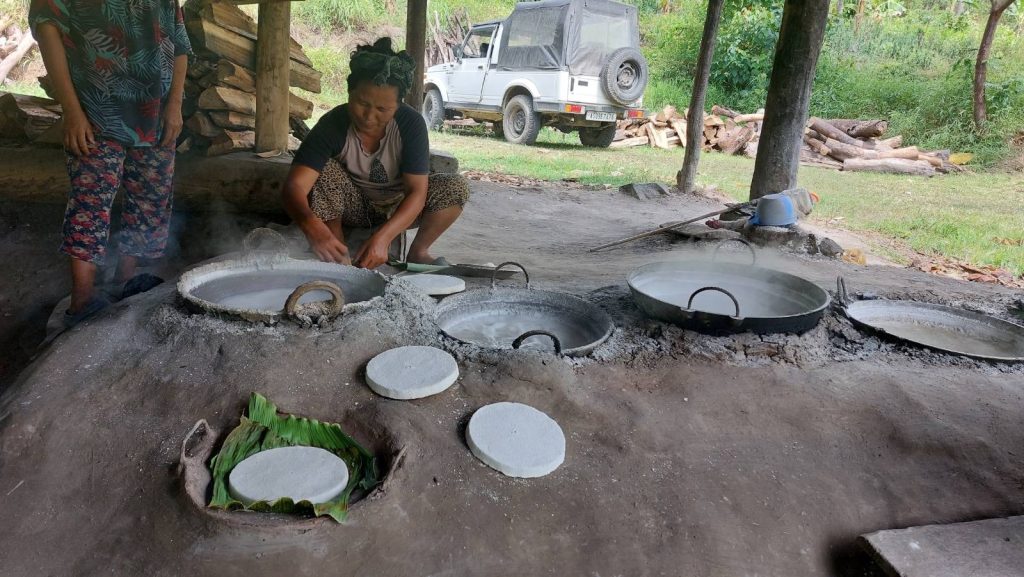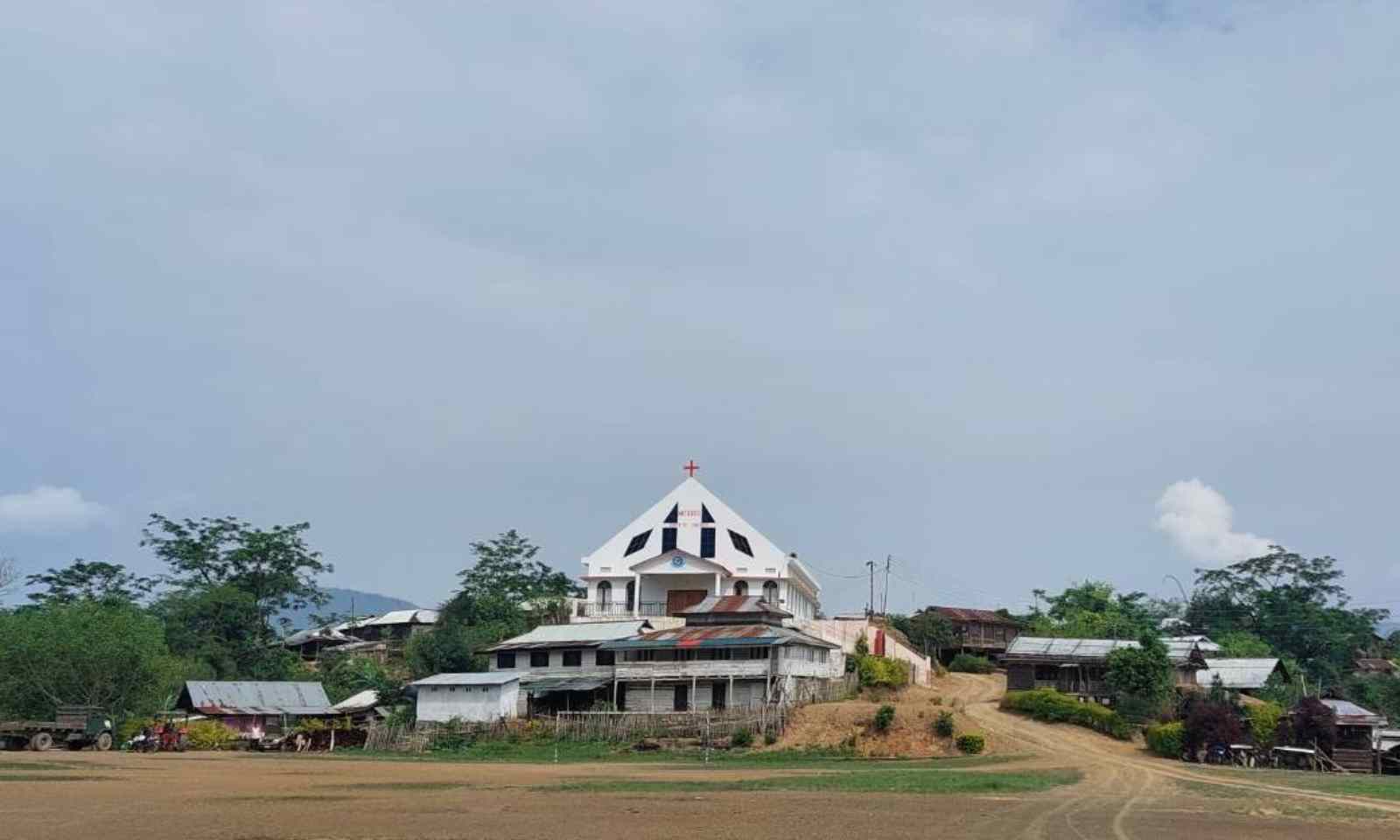The Journey Begins
I am a Myanmar-born ethnic Naga who recently arrived in Kohima, Nagaland, India, to work on the MyClimate Project, jointly implemented by The Highland Institute (THI) and the Danish Institute for International Studies (DIIS). Although I am a Naga, this was my first visit to Nagaland on the Indian side, so my knowledge of the area was limited. When we were selecting villages for the MyClimate project, a THI Board member suggested studying three or four villages near the Myanmar border. One of these was Machi village (pseudonym), home to the Pochury Naga tribe and famous for its salt production. On June 5, I set off for Machi with Joseph, who served as a driver and translator.
After 6 hours, we reached Machi, located on a low hill. The houses were quite small, and the large church seemed grand by comparison. Joseph called the Head Gaonbura[i](GB) and then drove us to his house. When the Head GB learned that I was a Naga born in Myanmar, he said, ‘We are no different from you. We are brothers and sisters’, and insisted that I address him as ‘brother’.
Surviving tragedy: a small village named Machi
Guided by the Head GB, we arrived at the home of 69-year-old Rev. Zhiwhuotho.He was smartly dressed, sitting in the living room, and waiting for us. After introductions, before we could ask any questions, Zhiwhuotho started talking about the village’s history:
There is no exact record of when this village [Machi] was founded. However, the elders estimate that it was established around 1880 [before India and Burma were separated by an international border]. … When this village was founded, it was named Nankho Village. However, when the village began producing salt, the Zemi Naga tribe traded salt with Nankho village. They referred to the village as ‘Machi’, meaning ‘where the salt is produced’. The name of the village gradually changed to ‘Machi’ over time.

Zhiwhuotho was the fifth-generation descendant of the village founder. He told us that his grandfather, father, and uncle had been beheaded in 1960, along with six others, during the conflict between the Naga Underground forces and the Indian Army. By way of explanation, he handed me a two-page document. It read, ‘The murder of innocent people in the aftermath of the attack on the Assam Rifles Post in Thuda (Phor) and the shooting down of transport aircraft Dakota by Naga resistance soldiers)’ and ‘The Shooting Down of the Dakota by Naga Underground Forces’.
The document described what had happened on 6September, 1960, which made horrifying reading. Later that day, I heard a first-hand account of the same event from a grandfather (Apfüse in the Chakhesang language) who had been tortured by the Army during this incident but managed to escape death. After the introductions, Apfüse began to speak: ‘We have experienced a nightmare that is difficult for humans to bear. I don’t think anyone in this world has ever suffered as much as our villagers.’
There was a moment of silence as Apfüse’s face displayed a sad, haunted expression mixed with compassion. He requested that I carefully record his words and write a book based on them.
Then, he continued:
On 6September, 1960, around 10 o’clock in the morning, the villagers were brutally murdered by Indian soldiers. The Indian soldiers entered the village and, with a terrifying voice, called the entire village out to gather. At that time, there were just over 10 houses in the village, close to each other, so the villagers had no chance to run away or hide. The whole village gathered around the Chief’s house. The women and children were asked to stand on one side, while the men [heads of households and adult men] were asked to stand on the other side. The soldiers made the men pull their ears and jump like frogs, forcing them to scream like monkeys. The victims were tied up and left to dry under the sun. While torturing them in that manner, the Indian soldiers continuously hit and beat them with their guns and sticks.
Apfüse’s adoptive father was the oldest in the village and unable to run. He described the appalling treatment meted out to this elderly man.
The soldiers trampled upon my father with their boots, delivering kicks and strikes with their guns. As a result, his thigh turned black, and his eyes swelled up to the point where he couldn’t even see. … Overwhelmed with sorrow for my father, I shouted, ‘Instead of enduring such brutal beatings, why not follow your friends if you cannot escape?’ I’m not sure how old I was at the time. I think I was around 14 years old. A soldier dragged me away for saying that, and I, too, was beaten like the other adults. I was punished alongside the village uncles on behalf of my father.
We then learned that Apfüse’s father and the other village elders were kept in the Chief’s house and then beheaded. He, himself, escaped from the soldiers by rolling down a hill and, although injured and exhausted, managed to meet up with the women and children, who had been driven into the forest by the soldiers. Most of the group eventually made their way to Losami village, where Naga Underground soldiers provided tents and food.
Apfüse went on:
The Naga soldiers sent us to the Sathi refugee camp on the Burmese side, stating that it was not safe for us to stay there [in Losami] for a long time. In the refugee camp, sixteen people had to share 1 kg of rice. … When we were in the village, only about two men would consume 1 kg of rice. Life was difficult in the refugee camp. …The elderly mothers reported to the relevant authorities that our children would starve to death if we continued living there, and they requested multiple times to return to their village. The Naga armed forces did not immediately allow us to return for our safety. So, we lived in that camp for over a year. Later, the Pochury Hoho [the customary governing body of the Pochury community] issued a statement saying that if no one returned to the village, other tribes would occupy it, and it was time to go back and rebuild the village.
Rebuilding Machi
As Apfüse narrated the village’s history, it filled me with a mixture of awe and reverence. His description of the village reconstruction was particularly moving.
Towards the end of 1962 and before the new year of 1963, we all returned to the village where our fathers had died. We were led by our mothers … Life was extremely difficult. … However, no matter how challenging it was, we built houses with whatever means we had. Historically, our village was first founded by our grandfathers. This second time, it was rebuilt by our mothers. Pochury people from neighbouring areas also came to assist … Despite the feelings of loss and sadness, the presence of people who extended help provided us with a sense of strength and support. At that time, the fifth generation of the elder who founded the village for the first time was only around 9 years old, so there was no one to be the head of the village, and the chieftaincy system was no longer practised.
According to the 49-year-old village Head GB, since 1963, more and more people have been moving to Machi. The village had plenty of land, and farms expanded. As a result, in 1984, the village elders stopped accepting people from other places. Currently, there are over 130 houses in Machi.
Rev. Zhiwhuotho had told us that, prior to 1960, Machi village was a family-oriented community filled with love, where people wholeheartedly followed the Chief’s leadership. Apfüse confirmed this:
Before 1960, this village was brimming with love. It was a delightful social haven. When we were young, there was no religious divide. Everyone would drink rice wine [zutho in the local language]. During that time, there were no religious teachings, yet people exhibited exceptional manners and conscientiousness. At that time, only five villagers had converted to Christianity [the village Chief was the first to convert. Other people were animists].
Apfüse’s description of the old village stressed the strong sense of community:
When a family faced difficulties, be it illness or other circumstances, the entire village would come together to offer assistance. They would collectively clean the houses of orphaned children, launder their clothes, and ensure they had enough food. Consequently, the village resembled one large family.
After the village was reestablished in 1962, the population gradually increased as people migrated from other areas, and those who moved in were registered with Machi village citizenship (at that time, they used citizenship instead of the Aadhaar Card, which is like a national identity card). All Machi citizens were granted the right to cultivate the hills and establish new farmland. The original landowners also had to sell some of their land to rebuild their families. According to Apfüse’s account, upon returning from the refugee camp after losing his parents and siblings, he had to exchange a plot of ancestral land for a pig from his aunt in another village as part of his wedding arrangement.
By 1970, the number of households in the village had reached approximately 70. Despite the positive aspects of population growth, such as new school buildings and collective efforts for community affairs, the Head GB expressed concerns about the environmental impact. The growing population’s shared utilisation of the village’s natural resources had strained the environment’s limited capacity, necessitating careful consideration.
Our interviewees told us that, starting in 1970, timber companies began purchasing timber from the village up to Akash Bridge, located roughly 20 kilometers outside the village. Subsequently, the number of entrepreneurs buying timber gradually increased, leading to an escalation in timber production from either the village’s land or private properties. This resulted in the depletion of large trees on the village’s land. Consequently, the village elders recognised the need to preserve the forests for future generations. In 1981 and 1982, they implemented measures to regulate the sale of wood from village land, imposing a specific limit of one carload per household per year. After 1982, timber production from village-owned land was completely prohibited by the village GB and council. If newlywed couples required wood for building their houses, they could only obtain it with the permission of the village head. However, the use of timber from private properties was left to the discretion of the individual.
Part II of this blog will look in more depth at the environmental problems now faced by the Machi villagers
Acknowledgements: I would like to extend my special thanks to everyone who helped make this trip possible, especially the Head GB and all the respondents.
____________________________________________________
[i]A Gaonbura in Nagaland is a leader appointed by the government to oversee administrative and community matters within their village. The office dates from the colonial period, when British officials appointed a village-level authority figure acting as a representative and mediator between the British government and the local community, ensuring smooth governance and resolving disputes.
A Village Reborn by the Hands that Rock the Cradle.
Visit to Machi- Part 1


